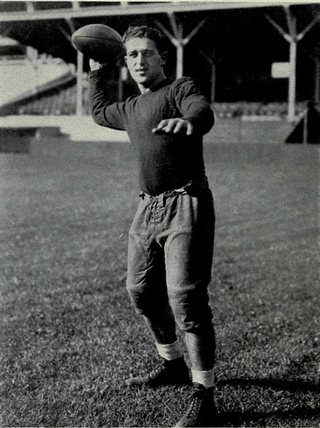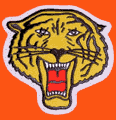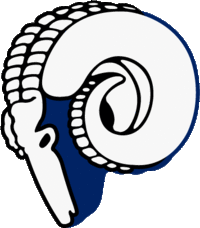Teams
Boston Shamrocks . The offensive powerhouse of the AFL in the 1936 season, the George Kenneally [4] -led Shamrocks were in a three-way battle with Cleveland and New York for the league championship when Boston beat the other two on consecutive weeks at the end of the season. The following year, the Shamrocks were beset with player defections and struggled to a 2–7 record. Playing its home games at Fenway Park and Braves Field, the team folded along with the league at the end of the 1937 season.
Brooklyn Tigers . Awarded a franchise in 1936 although no home field was available in Brooklyn, the Tigers had a short, troubled existence. In mid-November, the team moved to Rochester (changing its name to the Rochester Tigers) and played in Red Wing Stadium despite the failure of another AFL team based in that city mere weeks before. [5] The team limped to the end of the 1937 season before fading into oblivion. The Tigers were coached by Mike Palm, who owned the team along with Harry Newman.
Cleveland Rams . Owned by Homer Marshman and playing its home games in Cleveland Municipal Stadium, the Rams competed in the AFL for only one season (finishing second with a 5–2–2 record) with the league's stingiest defense and one of the league's two most potent offenses (along with Boston). When the NFL announced that it was willing to expand, Marshman applied for a franchise in the more-established league (along with representatives from Houston and Los Angeles). As a result, the Rams left the AFL for 1937 season, to be replaced by the people from Los Angeles whose NFL application was turned down. The 1936 Rams had Sid Gillman as a rookie end in his only season as an active professional player. [6]
New York Yankees . The second New York Yankees football team for an American Football League was coached by Jack McBride and featured the talents of star back Ken Strong. [6] Team president James Bush doubled as league president in the latter half of the 1936 season. Like the defending league champion Boston Shamrocks, the 1937 Yankees team was plagued by player defections to the NFL. Unlike the other New York Yankees football teams, the Yankees of AFL II had two home stadia: Yankee Stadium and Triborough Stadium on Randall's Island.
Pittsburgh Americans . While the Americans were holding their own on the football field in 1936, they lagged the rest of the league in attendance (2500 average attendance for home games in Forbes Field); although the Americans survived the first season as a middle-of-the-pack AFL team, the team was folded after the third game in 1937. The Americans were not without stars: they signed former Pirates Ben Smith and Loran Ribble.
Syracuse Braves . The existence of the Braves was doomed from lack of fan support while losing every game at Municipal Stadium (Don Irwin and end Red Badgro were the head coaches). The team moved to Rochester at midseason and called itself the Rochester Braves for a few weeks before calling it quits. At the lone home game in Red Wing Stadium (November 1, 1936) the second half was delayed 40 minutes by Braves players demanding back pay. The game was finished; the franchise folded immediately afterward. [5] Soon afterwards, another AFL team (Brooklyn) followed the Braves to Rochester in an effort to survive the 1936 season.
Cincinnati Bengals . Not related to the current NFL franchise, the Bengals joined the AFL for the 1937 season. Playing at Crosley Field, the team was a steady draw despite the team having a losing record. When the league folded at the end of the year, the Bengals continued as an independent team for 1938, joined the short-lived minor American Professional Football Association for 1939, and became a charter member of the third AFL in 1940. Hal Pennington was the team's originator; he was also the first head coach and general manager of the Bengals. [7]
Los Angeles Bulldogs . While an independent team, the Bulldogs defeated the Philadelphia Eagles in 1936. [8] After being turned down for the NFL for the 1937 season, the Bulldogs joined the AFL and became the first professional football team to play its home games on the West Coast. Averaging 14,000 in attendance for its home games in Gilmore Stadium, the Bulldogs were drawing twice as many fans per game as the rest of the league. Los Angeles did not lose or tie a game in its one season with the AFL, the first professional football team to win its league title with a perfect record. When the league folded at the end of the season, the Gus Henderson-led Bulldogs [4] continued on as an independent team before joining the minor league American Professional Football Association in 1939 and becoming a charter member of the Pacific Coast Professional Football League the following year.





